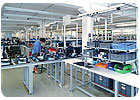
In large Hollywood productions, there are few cameras or lampheads on the set that don’t bear the ARRI logo. Arnold & Richter Cine Technik manufactures studio spotlights and other lighting equipment for the film industry. Over the years, the Bavarian company has earned more than a dozen Academy Awards for technical innovation.
“On average, equipment for a motion picture totals 5 percent to 10 percent of the film’s budget,” says Rainer Horn, head of lighting technology production. “A large part of it is allotted for lighting technology, and whoever is the quickest to deliver the largest quantities at the best price cuts the deal.”
While searching for ways to reduce delivery times, Horn recently turned to FMS Montagetechnik in Puchheim, Germany. Wolfgang Preuss, project manager and engineer, suggested restructuring ARRI’s assembly lines along lean production principles. The company purchased MPS Manual Production Systems from Bosch Rexroth Corp.
“Our initial approach was to categorize all work activities into pure assembly tasks as primary, value-adding processes on the one hand, and secondary activities, such as parts transport, setup and the like, on the other,” explains Horn. The goal was to find a system in which secondary activities would become largely obsolete.
The high-mix of products assembled in the plant was also taken into account. More than 45,000 lamp heads are currently produced annually in about 400 variants at ARRI’s plant in Stephanskirchen, Germany. Batch sizes are relatively small; even single units are part of the agenda.
The assembly process begins with the manufacture of components that are used to configure the lamp heads in their diverse combinations. Both upstream and downstream supply racks are assigned to workstations. The components needed at the different production points are supplied using the dual-container kanban principle.
To avoid long transport routes, the storage of C-parts, such as screws and standardized parts, was repositioned in direct proximity to the assembly lines. Preassembled components are kept in an interim storage space.
An MPS XLean flow rack adjusts easily to the parts containers, as well as the workpiece pallets that transfer products to the main conveyor. EcoFlow conveyor sections link the workstations until the final inspection station.
The new assembly line also had to be highly flexible. Horn’s main focus was the step in which a lamp head takes its specific form from the preassembled components. The longer it takes to reach this point, the quicker assemblers are able to react to incoming orders.
This involves designing the products to be modular and adjusting the assembly lines accordingly.
“Manual Production Systems from Rexroth allow us to convert assembly workstations, flow racks and conveyor sections easily and at any time,” says Horn. “Work activities can be rearranged, new activities added or material flows changed.”
Horn is happy with a production increase of almost 40 percent with the same personnel capacity and output. The earlier throughput times of up to four months can now be cut down to two to three weeks. “Today, we can deliver our standard range with a certainty down to the week or even the day,” Horn points out. In addition, spatial requirements were cut by 35 percent.
For more on manual production systems, visitwww.boschrexroth-us.comor call 800-739-7684.